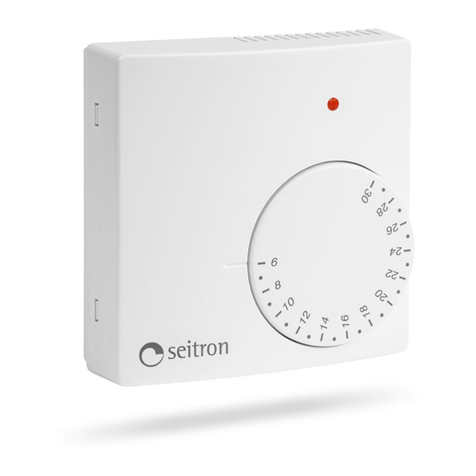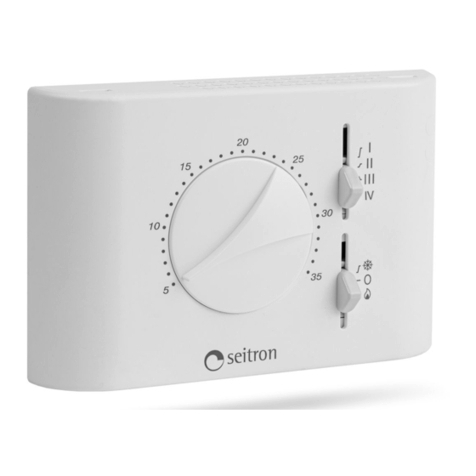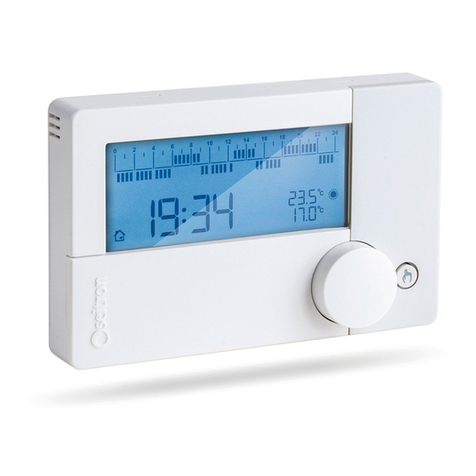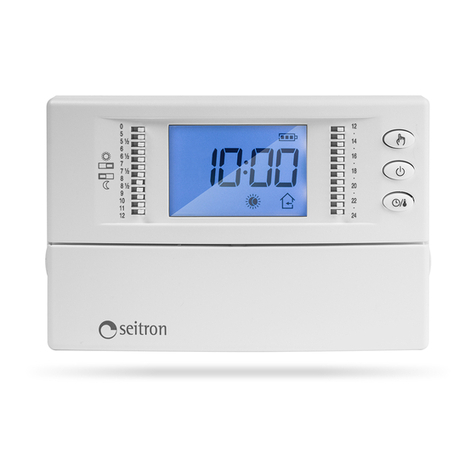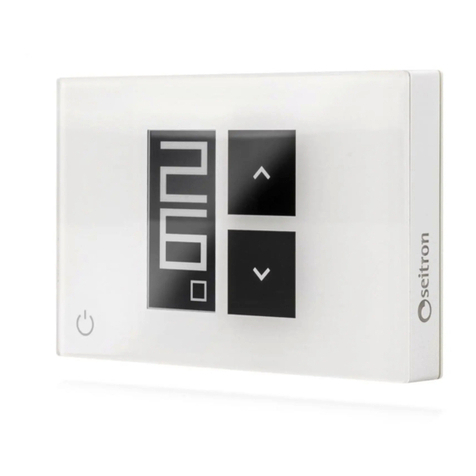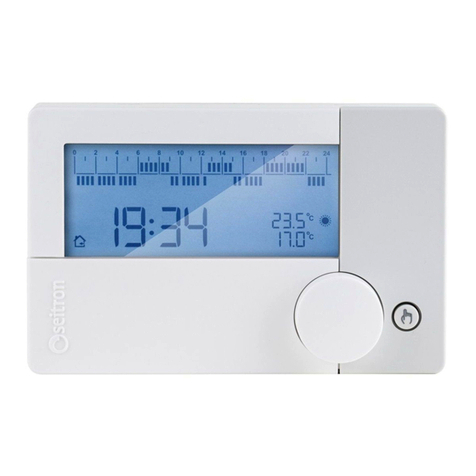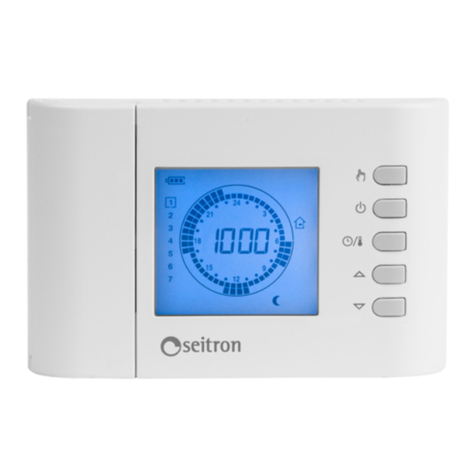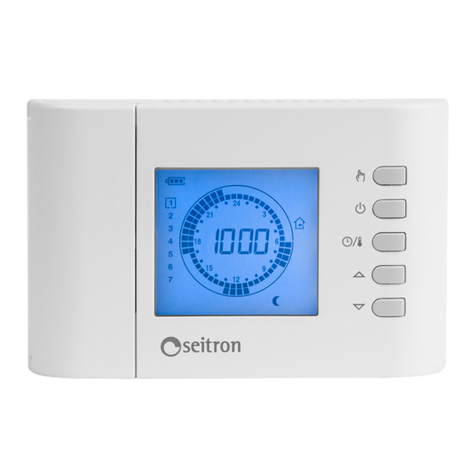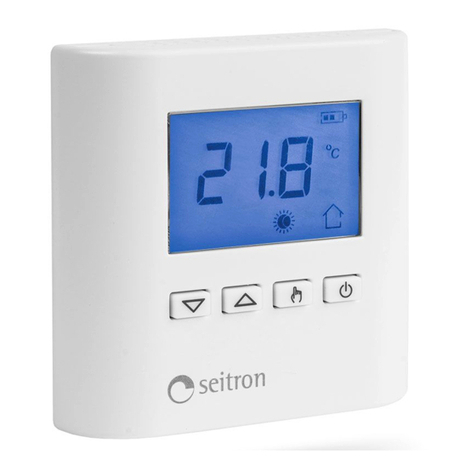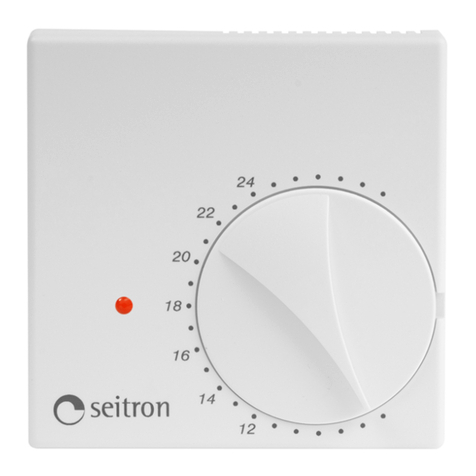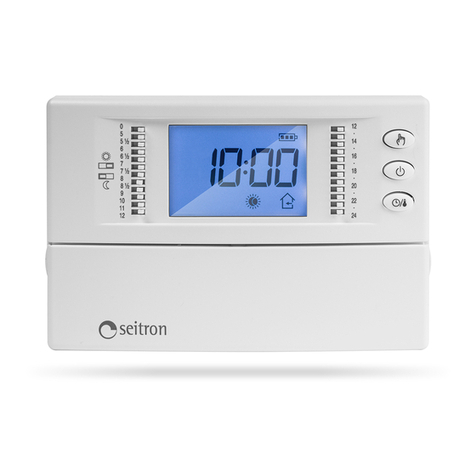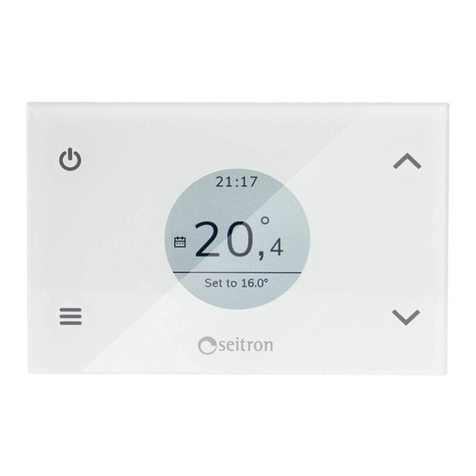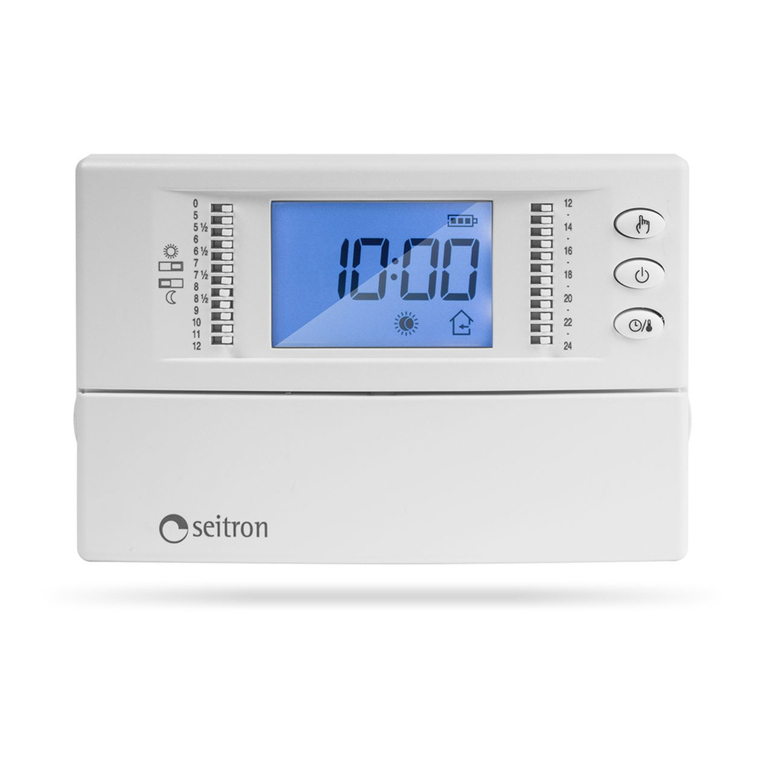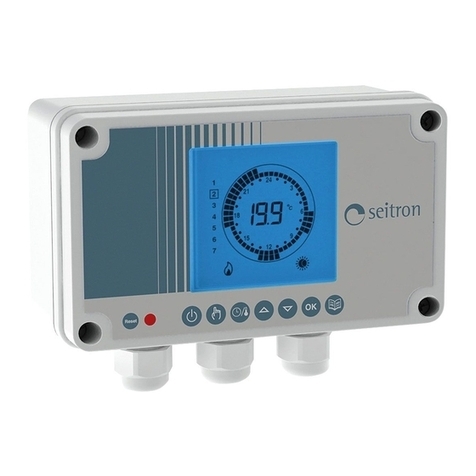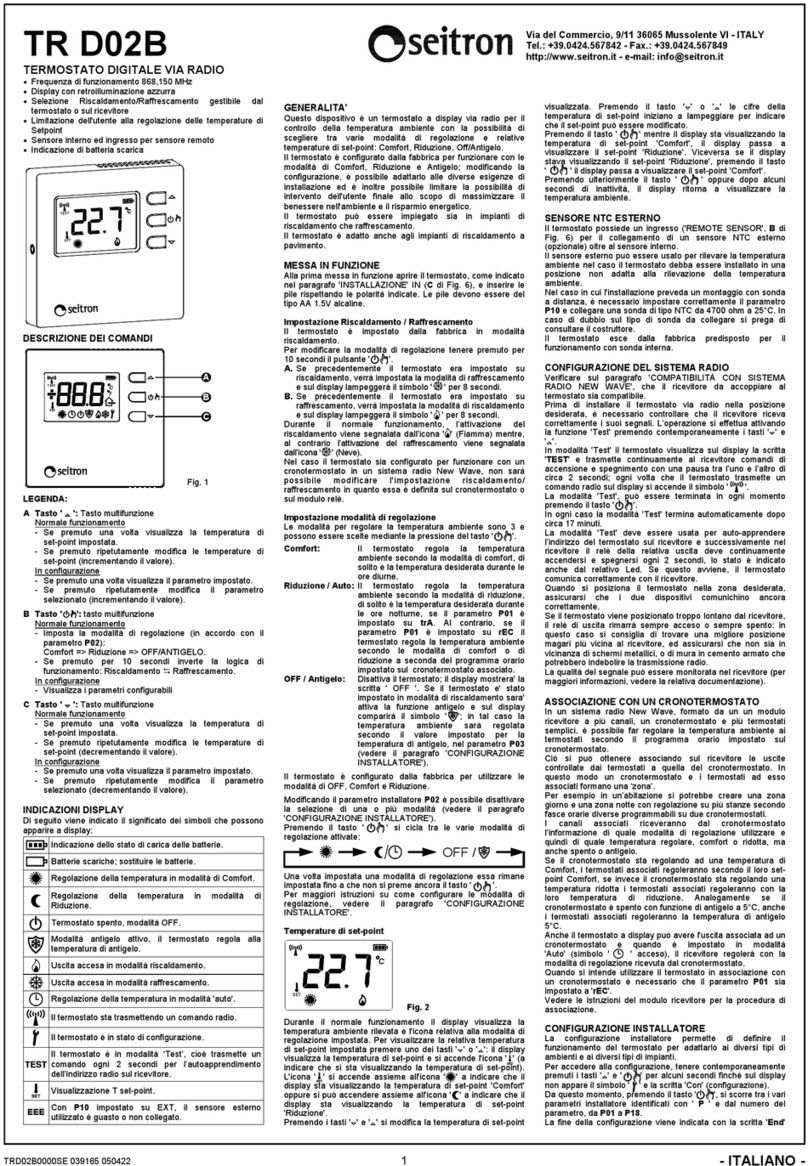
TBM01M0001SE 027561 101016 2
- ITALIANO / ENGLISH -
————————————————————————————————————————————
ITALIANO
————————————————————————————————————————————
GENERALITA’
•
Funzionamento in sistemi di riscaldamento
•
Alimentazione 230V~
•
Un ingresso per il collegamento di una sonda remota
•
Un’uscita a relè SPDT
•
Tre modalit di regolazione: Comfort, Riduzione e Antigelo
•
Regolazione dell’Offset sulla sonda remota
•
Regolazione dell’isteresi
•
Montaggio su barra DIN
FUNZIONAMENTO
IMPOSTAZIONE TEMPERATURA DI COMFORT E
RIDUZIONE
La temperatura di Comfort viene impostata tramite il
trimmer “F“ di Fig. 1 posto sul frontale, mentre quella di
Riduzione viene impostata tramite il trimmer “E” di Fig. 1)
Nota: Normalmente, per avere una riduzione notturna,
la temperatura di riduzione dovrà avere un valore
inferiore a quella di comfort.
IMPOSTAZIONE TEMPERATURA DI ANTIGELO
Tramite il trimmer G di Fig. 1, è possibile impostare una
temperatura minima (di antigelo) in modo tale da
preservare l’ambiente e l’impianto qualora la temperatura
ambiente scende al di sotto del valore impostato.
Il dispositivo esce dalla fabbrica con l’antigelo impostato a 0°C.
IMPOSTAZIONE ISTERESI
L’impostazione del trimmer H di Fig. 1, consente di definire
l’isteresi, in °C, che viene applicata al termostato. Il dispositivo
esce dalla fabbrica con l’isteresi impostata a 2,4°C.
ATTENZIONE: L’impostazione dell’isteresi deve essere
effettuata da personale qualificato, in quanto un valore
inappropriato può essere causa di funzionamenti anomali.
IMPOSTAZIONE OFFSET DELLA SONDA REMOTA
Tramite il trimmer I di Fig. 1, è possibile correggere la
temperatura rilevata dalla sonda remota, di ±3°C, in modo
da correggere eventuali errori sistematici di lettura dovuti
ad un eventuale posizionamento della sonda remota in zone
inadatte a rilevare la temperatura dell’ambiente.
Il dispositivo esce dalla fabbrica con l’Offset impostato a 0°C.
SONDA REMOTA
Al termostato deve essere collegata una sonda remota di
tipo NTC da 10KOhm a 25°C con adeguato valore per il
parametro beta ai morsetti 7 e 8. In caso di dubbio sul tipo
di sonda da collegare si prega di consultare il costruttore.
SELEZIONE SET-POINT (Terminali 9-10-11)
Questo dispositivo, per poter regolare la temperatura
ambiente in modalit comfort, riduzione e antigelo
necessita del collegamento, all’ingresso O di Fig. 1, di un
dispositivo atto a commutare tra le tre modalit , come ad
esempio un programmatore orario remoto (opzionale)
alimentato a 230V~ oppure 24V~.
Se l’ingresso non viene collegato, il termostato regola la
temperatura ambiente in modalit Comfort. Per maggiori
dettagli riferirsi al paragrafo “Collegamenti elettrici”.
CARATTERISTICHE TECNICHE
Alimentazione: 230V~ 50-60Hz
Assorbimento: 2VA (carico escluso)
Campo di regolazione:
Comfort: 5°C .. 40°C
Riduzione: 5°C .. 40°C
Antigelo: ±5°C (Default 0°C)
Isteresi: regolabile 0,2°C..5°C
(Default 2,4°C).
Offset sonda remota: ± 3°C (Default 0°C)
Portata contatti: 8(2)A 250V~ SPDT
(liberi da tensione)
Sensore remoto
Tipo di sensore: NTC 10KΩ ±1% @ 25°C
Range: -9,9°C .. +50,0°C
Precisione: ±1,0°C
Risoluzione: 0.1°C. ( 0.0°C .. 50.0°C)
0.2°C. (-9.9°C .. -0.1°C)
Grado di protezione: IP 40 (su quadro)
Temp. funzionamento: 0°C .. 50°C
Temp. stoccaggio: -10°C .. +50°C
Limiti umidit : 20% .. 80% RH
non condensante
Contenitore: Materiale: ABS autoestinguente V0
Colore: Grigio chiaro
Dimensioni: 53 x 69 x 90 mm (L x A x P)
Montaggio: 3 moduli barra-DIN
Classificazione secondo regolamento 2013.811.CE
Classe: I
Contributo all’efficienza energetica: 1%
RIFERIMENTI NORMATIVI
Il prodotto è conforme alle seguenti norme (EMC 2014/30/EU,
LVD 2014/35/EU e RoHS2 2011/65/CE):
EN 61000-6-1 (2007)
EN 61000-6-1 (2007)
EN 60335-1 (2012)
a
ATTENZIONE
- Per una corretta regolazione della temperatura
ambiente si consiglia di installare la sonda remota
lontano da fonti di calore, correnti d'aria o da pareti
particolarmente fredde (ponti termici).
- Per i collegamenti della sonda usare cavi di sezione
minima 1,5 mm² e di lung ezza massima di 25 m. Non
passare i cavi della sonda nelle canaline della rete.
- Collegare l'apparecc io alla rete di alimentazione
tramite un interruttore onnipolare conforme alle
norme vigenti e con distanza di apertura dei
contatti di almeno 3 mm in ciascun polo.
- L'installazione ed il collegamento elettrico del
dispositivo devono essere eseguiti da personale
qualificato ed in conformità alle leggi vigenti.
- Prima di effettuare qualsiasi collegamento accertarsi
c e la rete elettrica sia scollegata.
GARANZIA
Nell'ottica di un continuo sviluppo dei propri prodotti, il
costruttore si riserva il diritto di apportare modifiche a dati
tecnici e prestazioni senza preavviso. Il consumatore è
garantito contro i difetti di conformit del prodotto secondo
la Direttiva Europea 1999/44/EC nonché il documento sulla
politica di garanzia del costruttore. Su richiesta è disponibile
presso il venditore il testo completo della garanzia.
————————————————————————————————————————————
ENGLISH
————————————————————————————————————————————
OVERVIEW
•
Operation in heating systems
•
Power supply 230V~
•
Remote sensor input
•
SPDT relay output
•
Three modes regulation: Comfort, Economy and Antifreeze
•
Offset adjustment on the remote sensor
•
Hysteresis regulation
•
DIN rail mount
OPERATION
COMFORT AND ECONOMY TEMPERATURE SETTING
The Comfort temperature is set using the “F” trimmer of
Fig. 1, placed on the front panel, while the Economy
temperature is set using the “E” trimmer of Fig. 1.
Note: Normally, to ave a nig t Economy, t e
Economy temperature must be lower t an t e
Comfort one.
ANTIFROST TEMPERATURE SETTING
Through the G trimmer of Fig. 1, it is possible to set a
minimum temperature (Antifreeze) so that you can preserve
the room and the system if the room temperature gets
lower than the set value.
The device leaves the factory with the Antifreeze
parameter set to 0°C.
HYSTERESIS SETTING
The setting of the H trimmer of Fig. 1, allows to define the
hysteresis, in °C, which is applied to the thermostat. The
device is regulated by factory default with the hysteresis
set to 2,4°C.
WARNING: T e ysteresis setting must be carried out
by qualified operators, because an inappropriate
value could cause t e t ermostat to operate
anomalously.
OFFSET REGULATION OF THE REMOTE SENSOR
Through the I trimmer of Fig. 1, it is possible to adjust the
offset of the temperature detected by the remote sensor
by ±3°C, so to correct any systematic reading errors due
to any remote sensors placing in unfit areas to detect the
room temperature.
The device is set by factory default with the Offset at 0°C.
REMOTE SENSOR
A remote sensor type NTC 10KOhm at 25°C with a
suitable value for the beta parameter has to be connected
to the thermostat on the terminals 7 and 8. In case of
doubt about the kind of sensor you can connect please
contact the manufacturer.
SET-POINT SELECTION (Terminals 9-10-11)
In order to be able to set the room temperature in Comfort
mode, Economy mode and antifreeze the device needs to be
connected through the O input of Fig. 1, with a device which
can switch between the three modes, such as a remote time
programmer (optional) powered at 230V~ or 24V~.
When the input is left unconnected, the thermostat sets
the room temperature in Comfort mode. For more details
refer to the paragraph “Wiring diagrams”.
TECHNICAL FEATURES
Power supply: 230V~ 50-60Hz
Power absorption: 2VA (load excluded)
Regulation range:
Comfort: 5°C .. 40°C
Economy: 5°C .. 40°C
Antifreeze: ±5°C (default 0°C)
Differential: adjustable 0,2°C..5°C
(default 2,4°C).
Offset remote sensor: ± 3°C (default 0°C)
Contact capacity: 8(2)A 250V~ SPDT
(voltage free)
Remote sensor
Sensor type: NTC 10KΩ ±1% @ 25°C
Range: -9,9°C .. +50,0°C
Accuracy: ±1,0°C
Protection grade: IP 40 (on panel)
Operating temperature: 0°C .. 50°C
Storage temperature: -10°C .. +50°C
Humidity limits: 20% .. 80% RH non condensing
Case: Material: ABS self extinguishing V0
Color: Light grey
Dimensions: 53 x 69 x 90 mm (W x H x D)
Mounting: 3 modules-DIN rail case
Classification under reg. 2013.811.EC
Class: I
Contribution to energy efficiency: 1%
NORMATIVE REFERENCES
The product complies with the following standards
(EMC 2014/30/EU, LVD 2014/35/EU e RoHS2 2011/65/CE):
EN 61000-6-1 (2007)
EN 61000-6-1 (2007)
EN 60335-1 (2012)
a
WARNING
- To adjust properly room temperature, install t e
remote sensor far from eat sources, airstreams or
particularly cold walls (t ermal bridges).
- For remote version all wirings must be made using
wires wit 1,5 mm² minimum cross section and no
longer t an 25 m. Do not use same duct for signal
wires and mains.
- T e appliance must be wired to t e electric mains
t roug a switc capable of disconnecting all poles in
compliance wit t e current safety standards and
wit a contact separation of at least 3 mm in all poles.
- Installation and electrical wirings of t is appliance
must be made by qualified tec nicians and in
compliance wit t e current standards.
- Before wiring t e appliance be sure to turn t e
mains power off.
WARRANTY
In the view of a constant development of their products,
the manufacturer reserves the right for changing technical
data and features without prior notice. The consumer is
guaranteed against any lack of conformity according to the
European Directive 1999/44/EC as well as to the
manufacturer’s document about the warranty policy.
The full text of warranty is available on request from the
seller.


